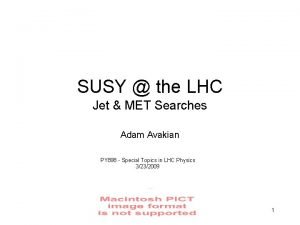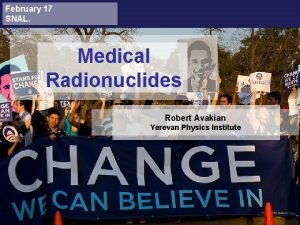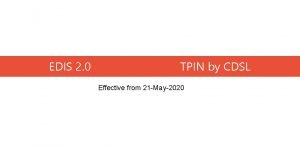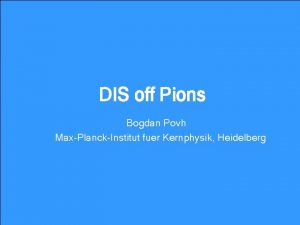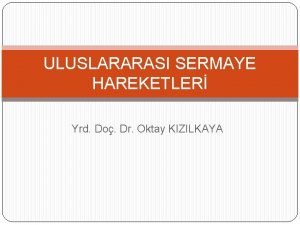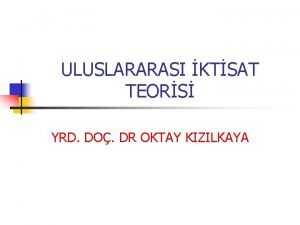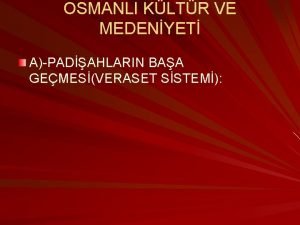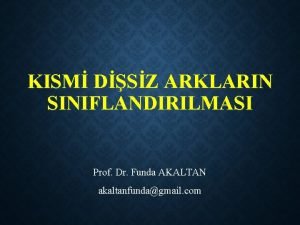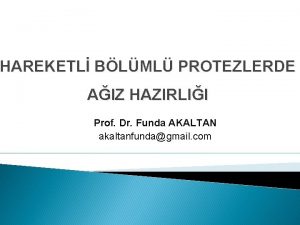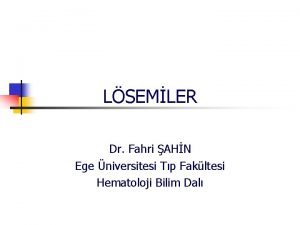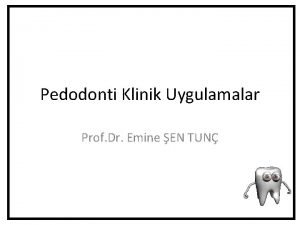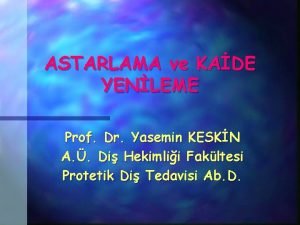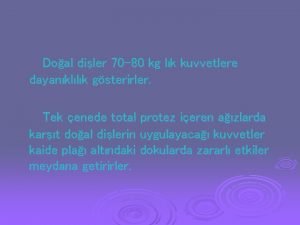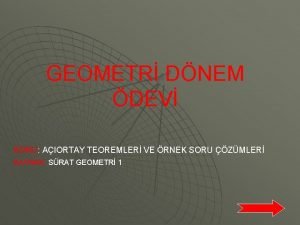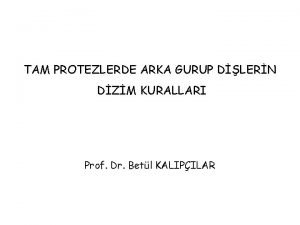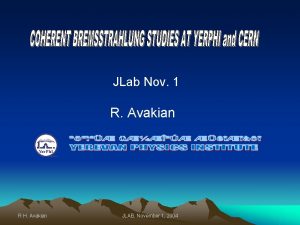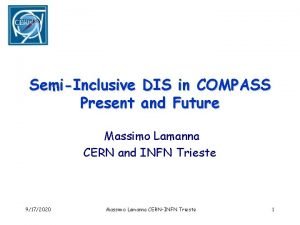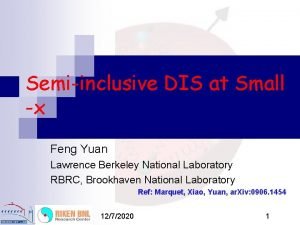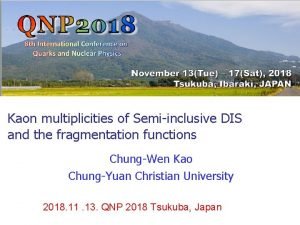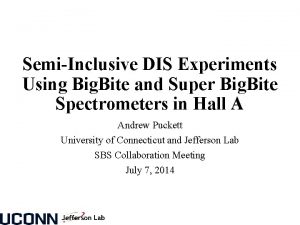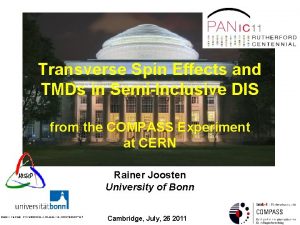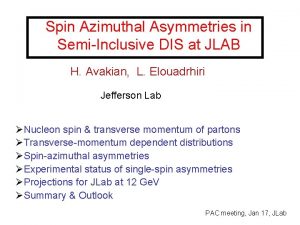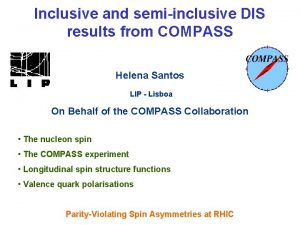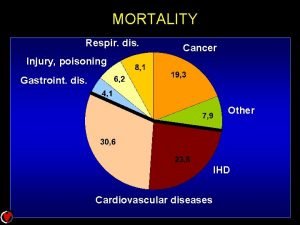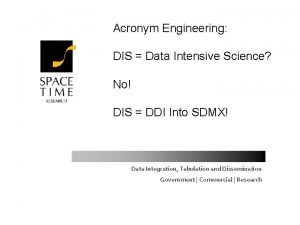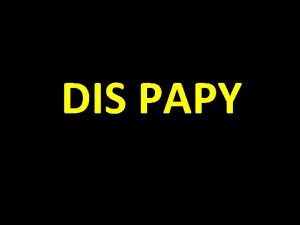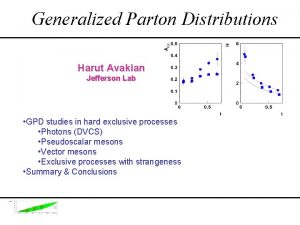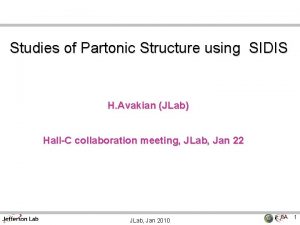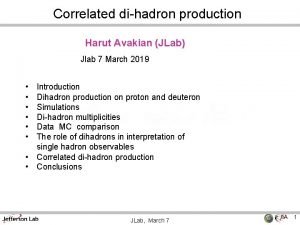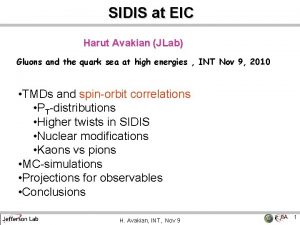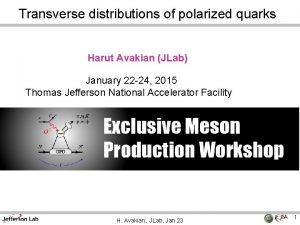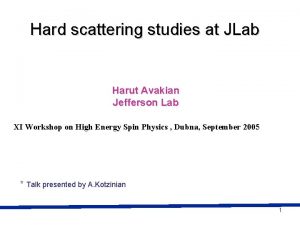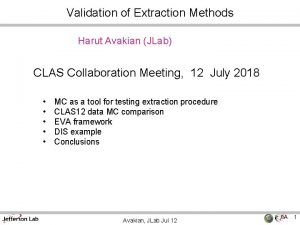Semiinclusive DIS at 12 Ge V H Avakian
























- Slides: 24

Semi-inclusive DIS at 12 Ge. V H. Avakian (JLab) For the semi-inclusive working group JLAB PAC January 10, 2005 ØSemi-inclusive processes ØFactorization at low energies ØLarge-x behavior of valence PDFs and flavor asymmetries of the sea ØTransversity and transverse momentum dependent distributions ØTarget fragmentation and intrinsic strangeness ØSummary

Semi-Inclusive Deep Inelastic Scattering (SIDIS) DIS: Major source of QCD tests and PDF studies • Probes only the sum of quarks and anti-quarks • Requires assumptions on sea • No access to transversity effect in LO SIDIS: “Tagging” to distinguish different quark flavors. • Provide access to quark distributions with fragmentation acting as a weight factor: • Probes orbital motion of quarks. Main focus of SIDIS studies: Øorbital angular momentum of quarks Øparton distributions at large x H. Avakian, Jan 10, 2005 2

SIDIS kinematic plane and relevant variables H. Avakian, Jan 10, 2005 3

SIDIS at leading twist e Unpolarized target Mulders et al. e Longitudinally pol. target p Boer Mulders Transversely pol. target e p Sivers transversity Off-diagonal PDFs vanish if quarks only in s-state! In addition T-odd PDFs require FSI (Brodsky et al. , Collins, Ji et al. 2002) ØFactorization of k. T-dependent PDFs proven at low PT of hadrons (Ji et al) ØUniversality of k. T-dependent distribution and fragmentation functions proven (Collins, Mets…)

Wpu(x, k, r) “Parent” Wigner distributions 2 d d 3 r k. T T) (F PDFs fpu(x), … dx d 2 k T Measure momentum transfer to quark k. T distributions also important for exclusive studies GPDs: Hpu(x, x, t), … x=0, t=0 TMD PDFs: fpu(x, k. T), . . Probability to find a quark u in a nucleon P with a certain polarization in a position r and momentum k FFs F 1 pu(t), F 2 pu(t). . Measure momentum transfer to target Exclusive meson data important in understanding of SIDIS measurements Some PDFs same in exclusive and semi-inclusive analysis Analysis of SIDIS and DVMP are complementary H. Avakian, Jan 10, 2005 5

ep→e’p. X: kinematic coverage at 11 Ge. V ØAcceptance in Q 2, Mx, PT gained with high luminosity and energy upgrade (at 6 Ge. V Mx<2. 5 Ge. V, Q 2<4. 5 Ge. V 2, PT<1 Ge. V) Øtest factorization in a wide kinematic range Østudy the transition between the nonperturbative and perturbative regimes of QCD Ømeasure PDFs and study higher twists H. Avakian, Jan 10, 2005 6

Collinear Fragmentation p quark The only fragmentation function at leading twist for pions in e. N→e’p. X is D 1(z) Ee =5. 7 Ge. V Hall-C Ee =5. 5 Ge. V No significant variation observed in p+/p- ratio and in z distributions of p+ for different x ranges (0. 4<z<0. 7, MX>1. 5)

A 1 p f-kinematic dependence for p+/-/0 A 1 p CLAS 5. 7 Ge. V A 1 p • No significant z-dependence of A 1 in the range 0. 4<z<0. 7 (p+p 0) • x dependence of CLAS A 1 p (A 2=0) consistent with HERMES data at x 3 higher Q 2 and with PEPSI (LUND)MC.

Polarized PDFs Ee =11 Ge. V NH 3+He 3 g 1 u=u, g 1 d=d…. Jlab @11 Ge. V • Asymmetry measurements with different hadrons (p+p-) and targets (p, n) allow flavor separation H. Avakian, Jan 10, 2005 9

Flavor decomposition: polarized sea • Predictions: – Instantons ( QSM): • First data from HERMES JLab @11 Ge. V 0 More data expected from RHIC W± production in future H. Avakian, Jan 10, 2005 10

Longitudinally polarized Target SSA for p+ Measurement of k. T dependent twist-2 distribution provides an independent test of the Collins fragmentation. Real part of interference of wave functions with L=0 and L=1 In noncollinear singlehadron fragmentation additional FF H 1(z, k. T) p quark k. T Efremov et al. • Study the PT – dependence of AULsin 2 f • Study the possible effect of large unfavored Collins function.

Transversely polarized target SSA transversely polarized quarks in a transversely polarized nucleon. Collins AUT ~ Interpretation requires large unfavored spin dependent fragmentation. • No success so far in describing consistently Collins SSA for all 3 pions at least in QSM! • More data needed, new observables GSI, CERN H. Avakian, Jan 10, 2005 12

Transverse Target SSA @11 Ge. V CLAS @ 11 Ge. V (NH 3) Collins p+ AUT ~ p 0 pf 1 T┴, requires final state interactions + interference between different helicity states Sivers AUT ~ Simultaneous (with pion SIDIS) measurement of, exclusive r, r+, w with a transversely polarized target important to control the background. H. Avakian, Jan 10, 2005 14

Transversity in double pion production The angular distribution of two hadrons is sensitive to the spin of the quark h 1 RT “Collinear” dihadron fragmentation described by two functions at leading twist: D 1(z, cosq. R, Mpp), H 1 R(z, cosq. R, Mpp) quark h 2 Collins et al, Ji, Jaffe et al, Radici et al. relative transverse momentum of the two hadrons replaces the PT in single-pion production (No transverse momentum of the pair center of mass involved ) Dihadron production provides an alternative, free” access to transversity H. Avakian, Jan“background 10, 2005 16

SIDIS: target fragmentation x. F>0 (current fragmentation) x. F - momentum in the CM frame x. F<0 (target fragmentation, TFR) Wide kinematic coverage at 11 Ge. V allows studies of hadronization in the target fragmentation region H. Avakian, Jan 10, 2005 17

Λ in target fragmentation e e’ 1Λ 2 π p L – unique tool for polarization study due to self-analyzing parity violating decay (ud)-diquark is a spin and isospin singlet → s-quark carries whole spin of L L polarization in TFR provides information on contribution of 6 strange sea to proton spin W. Melnitchouk and A. W. Thomas ‘ 96 J. Ellis, D. Kharzeev, A. Kotzinian ‘ 96 Polarized beam gives unique possibility to perform an “acceptance independent” measurement of L polarization in electroproduction.

JLab at 12 Ge. V Complementarity of high luminosity and wide geometric acceptance halls High luminosity polarised CW beam H. Avakian, Jan 10, 2005 Wide physics acceptance (exclusive, semiinclusive current and target fragmentation) 19

Summary Semi-inclusive measurements at 12 Ge. V will • provide precise information on the polarized valence distributions in the nucleon • test the expected flavor asymmetry in the polarized sea distributions • determine the essentially unknown transversity and Sivers functions with high precision and in a variety of channels sensitivity to orbital motion of quarks • improve the understanding of the fragmentation process and give access to the poorly understood target fragmentation region Essential for understanding the structure of the nucleon ! H. Avakian, Jan 10, 2005 20

support slides…. . H. Avakian, Jan 10, 2005 21

PT-dependence of beam SSA ssinf. LU(UL) ~FLU(UL)~ 1/Q (Twist-3) In the perturbative limit 1/PT behavior expected Nonperturbative TMD Perturbative region Asymmetries from k. T-odd and k. T-even (g 1) distribution functions are expected to have a very different behavior (flat A 1 p(PT) observed at 5. 7 Ge. V). H. Avakian, Jan 10, 2005 22

Measuring the Q 2 dependence of SSA ssinf. LU(UL) ~FLU(UL)~ 1/Q (Twist-3) For fixed x, 1/Q behavior expected Wide kinematic coverage allows to check the higher twist nature of beam and longitudinal target SSAs H. Avakian, Jan 10, 2005 23

g 1/f 1: PT-dependence Constant in perturbative limit Asymmetries from k. T-odd (f 1┴, h 1┴, g. T. . ) and k. T-even (g 1) distribution functions are expected to have a very different behavior H. Avakian, Jan 10, 2005 24

Transversity Sub-leading pion opposite to leading (into page) Simple string fragmentation (Artru model) L=1 r production may produce an opposite sign AUT r Leading r opposite to leading p(into page) SIDIS @11 Ge. V: 2 pions p+p 0(r+) Understanding of 2 pion asymmetries will help to understand transversity mesurements p+p-(r 0) H. Avakian, Jan 10, 2005 25

Λs in target fragmentation e e’ 1Λ 2 P and p- kinematics 6 π p
 Adam avakian
Adam avakian Adam avakian
Adam avakian Edis cdsl
Edis cdsl Fırat üniversitesi erasmus anlaşmalı üniversiteler
Fırat üniversitesi erasmus anlaşmalı üniversiteler Institut für kernphysik
Institut für kernphysik Examples of mis prefix
Examples of mis prefix Words with un prefix
Words with un prefix Uluslararası hizmetler hesabı
Uluslararası hizmetler hesabı Benjamin zephaniah dis poetry
Benjamin zephaniah dis poetry çoğalan maliyetler ve dış ticaret
çoğalan maliyetler ve dış ticaret Asakiri mansurei muhammediye anlamı
Asakiri mansurei muhammediye anlamı Tu dis que tu aimes les fleurs
Tu dis que tu aimes les fleurs Alveol kavsi nedir
Alveol kavsi nedir Pinley kron
Pinley kron Happily prefix
Happily prefix Politür lastiği
Politür lastiği Dis google finance
Dis google finance Interval nada enharmonis adalah
Interval nada enharmonis adalah Myelositer seri
Myelositer seri Prof dr emine şen
Prof dr emine şen Mukostatik
Mukostatik Programa dis
Programa dis Selektif basınçlı ölçü
Selektif basınçlı ölçü Iç açıortay teoremi
Iç açıortay teoremi Diş dizimi slayt
Diş dizimi slayt
